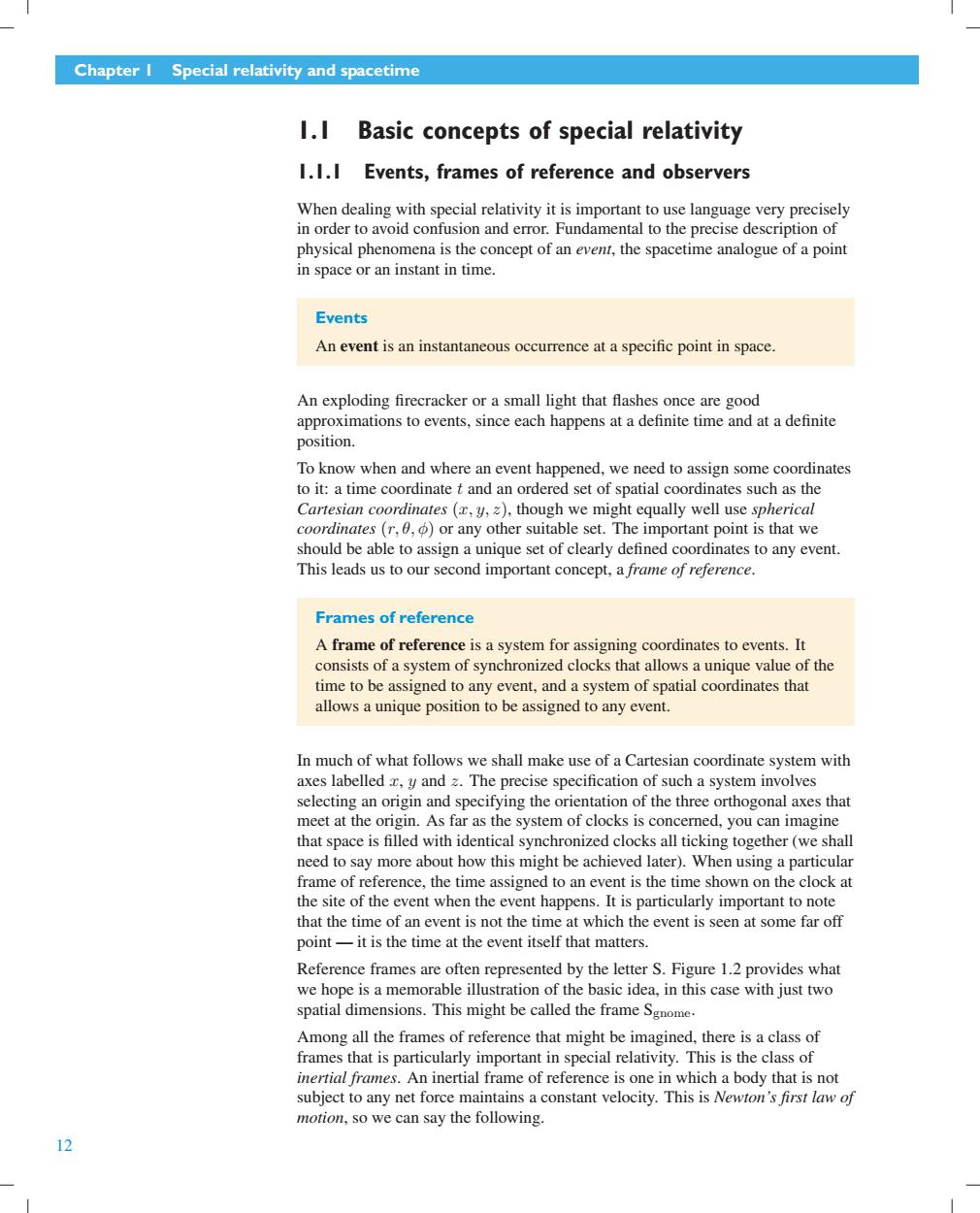正在加载图片...

Chapter I Special relativity and spacetime 1.I Basic concepts of special relativity 1.1.I Events,frames of reference and observers When dealing with special relativity it is important to use language very precisely in order to avoid confusion and error.Fundamental to the precise description of physical phenomena is the concept of an event,the spacetime analogue of a point in space or an instant in time. Events An event is an instantaneous occurrence at a specific point in space. An exploding firecracker or a small light that flashes once are good approximations to events,since each happens at a definite time and at a definite position. To know when and where an event happened,we need to assign some coordinates to it:a time coordinate t and an ordered set of spatial coordinates such as the Cartesian coordinates (x,y,z),though we might equally well use spherical coordinates(r,0,)or any other suitable set.The important point is that we should be able to assign a unique set of clearly defined coordinates to any event. This leads us to our second important concept,a frame of reference. Frames of reference A frame of reference is a system for assigning coordinates to events.It consists of a system of synchronized clocks that allows a unique value of the time to be assigned to any event,and a system of spatial coordinates that allows a unique position to be assigned to any event. In much of what follows we shall make use of a Cartesian coordinate system with axes labelled r,y and z.The precise specification of such a system involves selecting an origin and specifying the orientation of the three orthogonal axes that meet at the origin.As far as the system of clocks is concerned,you can imagine that space is filled with identical synchronized clocks all ticking together(we shall need to say more about how this might be achieved later).When using a particular frame of reference,the time assigned to an event is the time shown on the clock at the site of the event when the event happens.It is particularly important to note that the time of an event is not the time at which the event is seen at some far off point-it is the time at the event itself that matters. Reference frames are often represented by the letter S.Figure 1.2 provides what we hope is a memorable illustration of the basic idea,in this case with just two spatial dimensions.This might be called the frame Sgnome. Among all the frames of reference that might be imagined,there is a class of frames that is particularly important in special relativity.This is the class of inertial frames.An inertial frame of reference is one in which a body that is not subject to any net force maintains a constant velocity.This is Newton's first law of motion,so we can say the following. 12Chapter 1 Special relativity and spacetime 1.1 Basic concepts of special relativity 1.1.1 Events, frames of reference and observers When dealing with special relativity it is important to use language very precisely in order to avoid confusion and error. Fundamental to the precise description of physical phenomena is the concept of an event, the spacetime analogue of a point in space or an instant in time. Events An event is an instantaneous occurrence ataspecific point in space. An exploding firecracker or a small light that flashes once are good approximations to events, since each happens at a definite time and at a definite position. To know when and where an event happened, we need to assign some coordinates to it: a time coordinate t and an ordered set of spatial coordinates such as the Cartesian coordinates (x, y, z), though we might equally well use spherical coordinates (r, θ, φ) or any other suitable set. The important point is that we should be able to assign a unique set of clearly defined coordinates to any event. This leads us to our second important concept, a frame of reference. Frames of reference A frame of reference is a system for assigning coordinates to events. It consists of a system of synchronized clocks that allows a unique value of the time to be assigned to any event, and a system of spatial coordinates that allows a unique position to be assigned to any event. In much of what follows we shall make use of a Cartesian coordinate system with axes labelled x, y and z. The precise specification of such a system involves selecting an origin and specifying the orientation of the three orthogonal axes that meet at the origin. As far as the system of clocks is concerned, you can imagine that space is filled with identical synchronized clocks all ticking together (we shall need to say more about how this might be achieved later). When using a particular frame of reference, the time assigned to an event is the time shown on the clock at the site of the event when the event happens. It is particularly important to note that the time of an event is not the time at which the event is seen at some far off point — it is the time at the event itself that matters. Reference frames are often represented by the letter S. Figure 1.2 provides what we hope is a memorable illustration of the basic idea, in this case with just two spatial dimensions. This might be called the frame Sgnome. Among all the frames of reference that might be imagined, there is a class of frames that is particularly important in special relativity. This is the class of inertial frames. An inertial frame of reference is one in which a body that is not subject to any net force maintains a constant velocity. This is Newton’s first law of motion, so we can say the following. 12